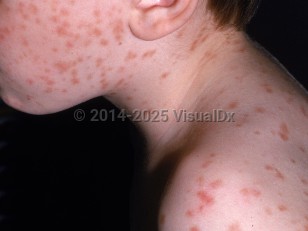Urticaria pigmentosa in Infant/Neonate
Alerts and Notices
Important News & Links
Synopsis

UP is the most common form of cutaneous mastocytosis in children. UP presents with few to many persistent, pink and brown macules and papules that urticate or wheal with thermal, mechanical, or chemical stimuli. Up to 25% of pediatric UP patients develop gastrointestinal symptoms. Fever, night sweats, malaise, epigastric tenderness, weight loss, flushing, diarrhea, syncope, bronchospasm, and problems with cognition signal possible systemic involvement.
Somatic c-kit mutations and other mast cell immunophenotypic alterations have been implicated in the pathophysiology of mastocytosis.
When triggered, mast cells release mediators such as histamine prostaglandins, eicosanoids, heparin, leukotrienes, cytokines, and proteases, causing patients with UP to become symptomatic. Triggers can include heat or temperature changes, trauma to skin lesions, insect stings, psychological stress, anxiety, and certain drugs such as NSAIDs, anesthetics, opioids, muscle relaxants, antibiotics, and iodinated radiocontrast agents.
UP can present at any time, but it commonly presents within the first weeks to months of life and can be expected to spontaneously involute by adolescence. There is no sex or race predilection. Partial to complete regression occurs in most children, as opposed to adults, in whom UP tends to persist.
Codes
Q82.2 – Mastocytosis
SNOMEDCT:
34739009 – Cutaneous mastocytosis, adult form
Look For
Subscription Required
Diagnostic Pearls
Subscription Required
Differential Diagnosis & Pitfalls

Subscription Required
Best Tests
Subscription Required
Management Pearls
Subscription Required
Therapy
Subscription Required
Drug Reaction Data
Subscription Required
References
Subscription Required
Last Updated:03/26/2020

